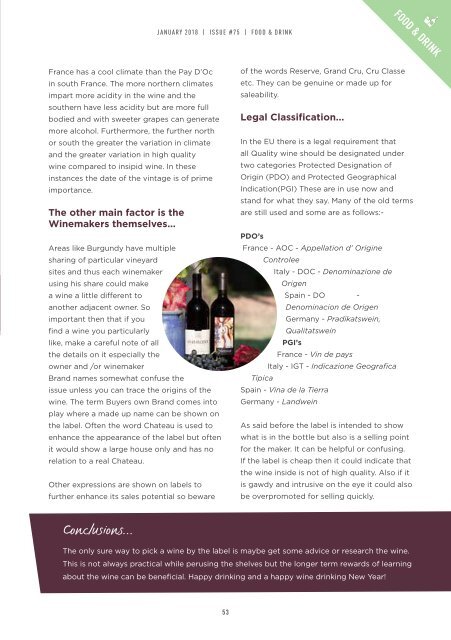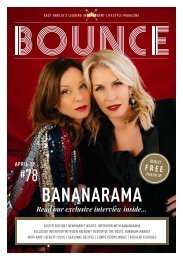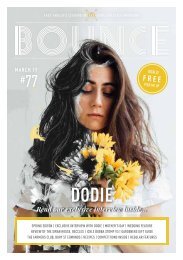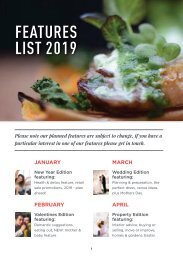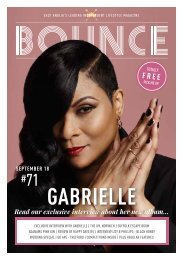Bounce Magazine January 2019
The New year Edition, featuring West End and Broadway star, Ramin Karimloo, along with a Healthy new you feature, wedding special, Jess Glynne, From The Jam, detox recipes, competitions and much more!
The New year Edition, featuring West End and Broadway star, Ramin Karimloo, along with a Healthy new you feature, wedding special, Jess Glynne, From The Jam, detox recipes, competitions and much more!
You also want an ePaper? Increase the reach of your titles
YUMPU automatically turns print PDFs into web optimized ePapers that Google loves.
FOOD & DRINK<br />
JANUARY 2018 JANUARY | ISSUE <strong>2019</strong> #75 | ISSUE | FOOD #75 & DRINK<br />
France has a cool climate than the Pay D’Oc<br />
in south France. The more northern climates<br />
impart more acidity in the wine and the<br />
southern have less acidity but are more full<br />
bodied and with sweeter grapes can generate<br />
more alcohol. Furthermore, the further north<br />
or south the greater the variation in climate<br />
and the greater variation in high quality<br />
wine compared to insipid wine. In these<br />
instances the date of the vintage is of prime<br />
importance.<br />
The other main factor is the<br />
Winemakers themselves...<br />
Areas like Burgundy have multiple<br />
sharing of particular vineyard<br />
sites and thus each winemaker<br />
using his share could make<br />
a wine a little different to<br />
another adjacent owner. So<br />
important then that if you<br />
find a wine you particularly<br />
like, make a careful note of all<br />
the details on it especially the<br />
owner and /or winemaker<br />
Brand names somewhat confuse the<br />
issue unless you can trace the origins of the<br />
wine. The term Buyers own Brand comes into<br />
play where a made up name can be shown on<br />
the label. Often the word Chateau is used to<br />
enhance the appearance of the label but often<br />
it would show a large house only and has no<br />
relation to a real Chateau.<br />
Other expressions are shown on labels to<br />
further enhance its sales potential so beware<br />
of the words Reserve, Grand Cru, Cru Classe<br />
etc. They can be genuine or made up for<br />
saleability.<br />
Legal Classification...<br />
In the EU there is a legal requirement that<br />
all Quality wine should be designated under<br />
two categories Protected Designation of<br />
Origin (PDO) and Protected Geographical<br />
Indication(PGI) These are in use now and<br />
stand for what they say. Many of the old terms<br />
are still used and some are as follows:-<br />
PDO’s<br />
France - AOC - Appellation d’ Origine<br />
Controlee<br />
Italy - DOC - Denominazione de<br />
Origen<br />
Spain - DO -<br />
Denominacion de Origen<br />
Germany - Pradikatswein,<br />
Qualitatswein<br />
PGI’s<br />
France - Vin de pays<br />
Italy - IGT - Indicazione Geografica<br />
Tipica<br />
Spain - Vina de la Tierra<br />
Germany - Landwein<br />
As said before the label is intended to show<br />
what is in the bottle but also is a selling point<br />
for the maker. It can be helpful or confusing.<br />
If the label is cheap then it could indicate that<br />
the wine inside is not of high quality. Also if it<br />
is gawdy and intrusive on the eye it could also<br />
be overpromoted for selling quickly.<br />
Conclusions...<br />
The only sure way to pick a wine by the label is maybe get some advice or research the wine.<br />
This is not always practical while perusing the shelves but the longer term rewards of learning<br />
about the wine can be beneficial. Happy drinking and a happy wine drinking New Year!<br />
53


